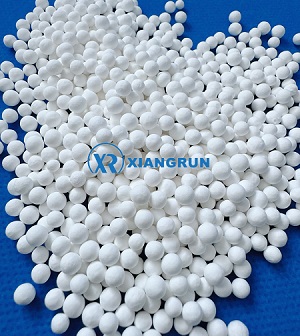Activated alumina is a porous, highly dispersed solid material with a high specific surface area and excellent surface activity. It is a highly effective dechlorination agent widely used in industry and laboratories. Activated alumina dechlorination agents are primarily used to remove chloride impurities from various gases and liquids. Besides petroleum dechlorination, what other applications can it be used for?
1. Petrochemical Industry
Olefin Feedstock Purification: In cracking units, feedstocks (such as naphtha) may contain chlorides, or chlorides may be added as inhibitors during the production process. These chlorides can poison downstream polymerization catalysts. Activated alumina, placed after the dryer, is used to deeply remove these trace amounts of hydrogen chloride, protecting expensive catalysts.
Reforming Units: During the catalytic reforming process, chlorides in the feedstock and those generated during catalyst regeneration need to be removed to protect system equipment and subsequent catalysts.
Natural Gas and Refinery Gas Processing: During oil and gas extraction and refining, natural gas and refinery gas may contain acidic gases such as HCl. Activated alumina is often used in tandem with desulfurizers such as zinc oxide to achieve simultaneous desulfurization and dechlorination.
2. Chemical Industry and Synthesis Gas
Ammonia and Methanol Feed Gas Purification: Synthesis gas (H₂ + CO) produced from coal or natural gas often contains trace amounts of HCl. These chlorides can severely poison the catalysts used in ammonia and methanol synthesis. Activated alumina is an essential barrier to protect these critical catalysts.
Coal Chemical Industry: In coal-to-gas and coal-to-liquids processes, the gas produced by coal gasification contains large amounts of hydrogen chloride, which requires extensive purification.
3. Air Separation and Refrigeration
Air separation units: Compressed air may contain chlorine-containing compounds (such as chloroform and carbon tetrachloride). These substances can accumulate in liquid oxygen and potentially form explosive gases. Activated alumina is used to pretreat air to ensure safe operation of air separation units.
Freon refrigerant production: During the production process, hydrogen chloride must be removed from the raw gas or intermediate products to ensure product purity and protect equipment from corrosion.
4. Other Applications
Electronics Industry: Used to protect the production environment of electronic components and remove trace chlorides from specialty gases.
Environmental Protection: Used to treat chlorine-containing industrial waste gas.
Activated alumina dechlorination agents primarily remove inorganic chlorides, particularly:
Hydrogen chloride: This is the primary target.
Under certain conditions, it can also remove some organic chlorides, but its efficiency and specificity are not as high as dedicated organochlorine conversion catalysts (which typically convert organic chlorides into hydrogen chloride before removal).
Advantages of the ALUSORB-CL104 dechlorination agent produced by Zibo Xiangrun:
High dechlorination accuracy: Can reduce the chlorine content in the gas to 0.1 ppm or even lower.
High chlorine capacity: High chlorine capacity by weight and long service life.
High mechanical strength: Resists wear, can withstand bed pressure, and reduces dust generation.
Good selectivity: Can selectively dechlorinate under specific conditions.
ALUSORB-CL104 dechlorination agent offers exceptional performance in terms of chlorine capacity, strength, dechlorination accuracy, and adaptability, making it your optimal dechlorination choice.
If you have questions or require activated alumina dechlorination agent, please contact Zibo Xiangrun Environmental Engineering Co., Ltd., a professional alumina manufacturer.













